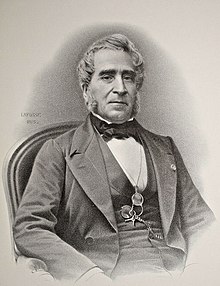Gaspard Thémistocle Lestiboudois

Gaspard Thémistocle Lestiboudois (12 October 1797, Lille – 22 November 1876, Paris) was a French naturalist. He was the son of botanist François Joseph Lestiboudois (1759-1815) and the grandson of Jean-Baptiste Lestiboudois (1715-1804), a professor of botany at the Faculty of Lille.
In 1818, he obtained his doctorate of medicine in Paris. In 1835 he conducted research of the plague in Algeria.[1] As a passenger on a train, he was involved in a terrible accident at Rœux; despite being injured, he attended to the wounds of other victims.[2]
In August 1868 he was chosen commander of the Legion of Honour.[3]
Written works[edit]
Known for his early investigations of phyllotaxis, in 1848 he published Phyllotaxie anatomique.[4][5] Other noted works by Lestiboudois include:
- Essai sur la famille des Cypéracées, 1819 - Essay on the family Cyperaceae.
- Études sur l'anatomie et la physiologie des végétaux, Paris : Treuttel et Wurtz, 1840 - Studies on the anatomy and physiology of plants.
- Économie pratique des nations, ou Système économique applicable aux différentes contrées, et spécialement à la France, 1847
- Voyage en Algérie, ou Études sur la colonisation de l'Afrique française, 1853 - Voyage to Algeria; studies on the colonization of French Africa.[1]
References[edit]
- ^ a b Sociétés savantes (biographical and bibliographical text)
- ^ Statement based on a translation of an equivalent article at the French Wikipedia.
- ^ Lenore Notice no LH/1617/41
- ^ Oxford Journals A History of the Study of Phyllotaxis
- ^ Google Books Phyllotaxie anatomique
- ^ International Plant Names Index. T.Lestib.
